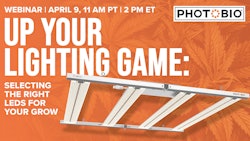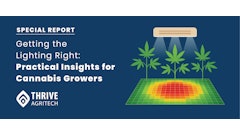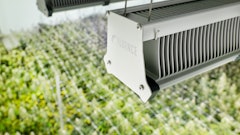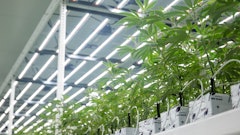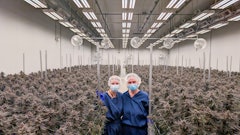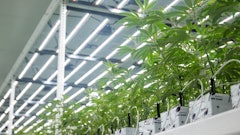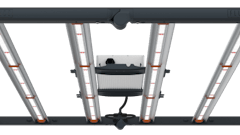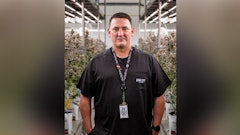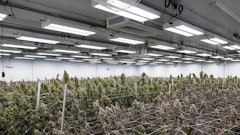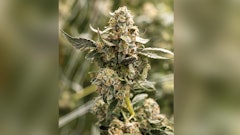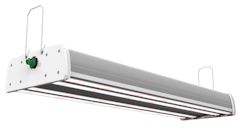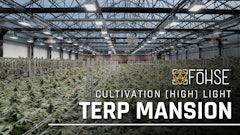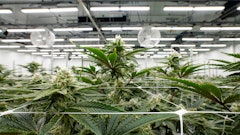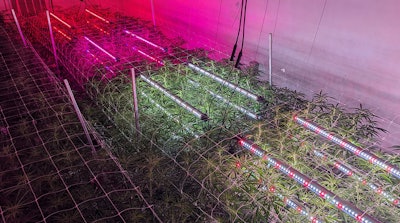
For the past five years, Jason Sanders, director of cultivation at Texas Original (TXOG), has been running various trials to optimize production at the company’s indoor grow, exploring outcomes from ramping up light intensity, tweaking plant densities, planting in smaller containers and reducing vegetation and propagation times.
Technology, including round the clock monitoring and data collection of key aspects of the environment such as temperature, humidity and light intensity, have helped provide Sanders and his team with metrics needed to support these studies.
Much of the research has been on the impact of changing parameters of top lighting using LED fixtures, including using dimming controls to replicate the sun’s natural rise and set. But lately, intercanopy lighting has been on his mind.
“The big question is, what happens when we start to move light into the canopy? Is there an economical benefit to moving the light inside the canopy?” Sanders says. “Not just increasing yield or potency, but what does that do for increasing the quality of flower throughout the plant from the lower to the top flowers?”
Traditionally, growers have mimicked the sun when adding lighting to greenhouses and indoor facilities, hanging fixtures above plants from ceilings, roofs or tiers in the case of vertical grows. But anecdotally, interest in the potential benefits of illuminating more of the plant seems to be growing.
The yearlong studies at TXOG’s 7,200-square-foot, controlled-environment indoor facility in Manchaca so far have examined various aspects of intercanopy lighting, including light placement (between plants or below the canopy) and intensity levels, Sanders says.
“We are seeking to understand the best deployment of this strategy, whether it be in the canopy, below the canopy, something in between, and if the benefits are as pronounced when working at high or low total intensities,” Sanders says.
One other question driving the research is if adding intercanopy lighting would help reduce labor—if there is more flower development on the lower branches, not only does that increase yield and quality, but it reduces the amount of defoliation needed.
“Early indications are showing that flowers further down in the canopy are of a higher grade than normal, and we are seeing less trimming waste,” Sanders says.
That makes sense to Dr. David Hawley, principal scientist at Fluence, which established the research at TXOG through a partnership with the fellow Texas-based company.
Like other crops, cannabis can be dense at the top, shading the bottom of the plant and cutting off valuable light that could otherwise drive growth.
“Anecdotally, [intercanopy lighting] is something that we suspected could be valuable for a while for the same reasons that we believed it could be valuable in vine plants, like tomato and cucumber. Anytime you have a really dense canopy with a lot of vegetative tissue, chances are a good fraction of that tissue isn't being very productive,” Hawley said. “In the world of plant development, leaves are functionally just little biological solar panels. And if you've invested the energy in growing those solar panels, but then you don't put any light on them, that's inefficient.”
From this research and other studies, they’ve found that intercanopy lighting can help elevate the grade of the flower on lower branches—meaning buds that would be considered B or C class are now B or A grade.
“Buds just have a higher market value. In terms of quality and consistency, it's very good. Not only are we elevating the quality of bud, but also the variability in bud size and bud grade … also [is] significantly reduced,” Hawley says.

This stability is crucial in any cannabis market and is especially aligned with Texas Original’s goals of producing consistent products and dialing in how production changes impact results.
“We want to understand how all aspects of our production affect that product. If we learn that a certain lighting strategy can impact some terpene ratio, for example, and clinical research in the future discovers that that terpene ratio is important for treating a certain ailment, we want to know how to tweak our environment to make the best medicine possible,” Sanders says. “[Research] also makes us better cultivators overall.”
Study Details
The first intercanopy lighting study at TXOG examined how plants performed when the proportion of red light in the intercnaopy spectrum increased, says Brian Poel, research and project manager for Fluence.
"Because intercanopy lighting treatments with increasing red light intensities can be more efficient (or lower energy cost per photon), we were interested in learning if there was any difference in yield or quality of cannabis flower at different levels of red light content," Poel says. "If there were no difference, a higher red light concentration would be better for production because of the increased energy efficiency. We tested spectra at approximately 40%, 60%, 80% and 100% red light, which were achieved by hanging light bars inside the canopy."
Poel says they found there were no "major differences in yield or potency" when increasing the levels of red light in the intercanopy spectrum. However, red intercanopy treatments at 80% and 100% caused photobleaching. Future trials are using 60% red, he says. Now, they are looking at intensity of top and intercanopy lights.
"We’re currently obtaining data from a series of experiments examining the optimal amount of light to move inside the canopy via intercanopy lighting. Early indications demonstrate that increasing ICL doesn’t necessarily increase total yield compared to top lighting alone when total light flux is equal—but we did see an increase in average bud size, especially lower in the canopy," Poel says.
Diving Deeper
Lighting is just one aspect of cannabis cultivation that has evolved at a breakneck pace as the commercial, licensed industry has come online, and Hawley says despite the early evidence of intercanopy lighting, there is not widespread adoption.
“There's more anecdotal curiosity and anecdotal claims. But in terms of just really objective studies like what we've done so far, not many groups have done that. So growers are still understandably skeptical,” he says.
There’s also still more to be discovered, Hawley says, including what light placement is optimal—subcanopy or between the plants—for the best results.
“So much of how you optimize growth is dependent on what's going on with the canopy itself. If you're growing a cultivar of cannabis or cultivars of cannabis that are very, very dense, if you were to use intercanopy lighting, you might not get very good light penetration. So that added light just isn't really doing very much in a model like that,” Hawley says. “You might benefit more from subcanopy or you might benefit from reducing plant density a little bit. Conversely, if you're growing a variety that has a little bit more space between the branches, intercanopy [could] be equally effective as anything else. So I think the bigger consideration, whether you do intercanopy or sub canopy, is just what products are available to you and do you have a way of implementing those products in a way that's not going to interfere with your growth?”
One concern Poel noted is working around the intercanopy lighting fixtures, including navigating trellis netting. Fluence has developed guides to provide growers with installation tips.
"Developing a system to hang the intercanopy bars inside the canopy was a bit of a challenge at first—hanging the bars conflicted with the trellis system needed to keep the crop upright and trained properly," Poel says. "After initially putting up and taking down the bars manually, our team developed an innovative hanging method using simple hardware to mount the bars from the posts of the trellis"
Another that Sanders is studying is what is the optimal intensity inside or below the canopy—which will be closer to the plants—to help support growth but prevent photobleaching.
Hawley says that is something that Fluence has studied, looking at four treatments of top and intercanopy lighting with varying light intensities.
This research is also important when considering spectrum, something top of mind for Hawley, as the parameters can differ with intercanopy lighting because the relative intensity is lower. For high intensity top lighting, too much red can bleach plants, which is why LED manufacturing has moved toward more broad-spectrum lighting, with about 40% red distribution.
“Intercanopy is about 68-ish percent red. The reason that we can do that with intercanopy lighting but not top lighting is because the relative intensity applied with intercanopy lighting is lower,” Hawley says. “With top light intensities beyond 1000 µmol·m-2·s-1 that most commercial growers have adopted these days, 60-ish percent red in the spectrum is too much. That’s likely to bleach the top of the canopy with most cultivars or most genetics on the market. But with intercanopy, because the intensity light source is lower, you can get away with that higher red fraction.”
As with all trials TXOG operates, they will continue to replicate this experiment.
“This replication is important because it allows us to tease out any other factors about the production, like inherent differences in productivity between cultivation rooms, or differences in crop yield in different parts of the room,” Sanders says. “That could confound what we think we’d be learning about a lighting treatment in a single run of a study.
“As farmers, it’s great to be continuously learning.”











